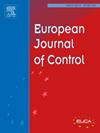利用建设性障碍物反馈进行安全排线和并线控制
IF 2.5
3区 计算机科学
Q2 AUTOMATION & CONTROL SYSTEMS
引用次数: 0
摘要
本文提出了一种新颖的编队控制设计,用于在多车道道路场景中对一组车辆进行安全排查和合并。在对领头车辆进行独立控制的前提下,目标是控制跟随车辆在所需车道上行驶,与相邻(前方)车辆保持一定距离,同时防止与相邻车辆和道路边缘发生碰撞。受最近提出的建设性障碍反馈概念的启发,为每辆跟车提出的控制器由两部分组成:一部分是标称控制器,确保其跟踪邻近车辆;另一部分是用于避免碰撞的发散流耗散项,在不影响标称控制器性能的情况下,减缓邻近车辆和道路边缘方向的相对速度。这项工作的主要贡献在于,所提出的控制方法通过计算效率和系统稳定性分析,确保了多车道道路场景下的无碰撞排线和并线控制。仿真结果证明了所提算法的有效性。本文章由计算机程序翻译,如有差异,请以英文原文为准。
Safe platooning and merging control using constructive barrier feedback
This paper proposes a novel formation control design for safe platooning and merging of a group of vehicles in multi-lane road scenarios. Provided a leader vehicle is independently controlled, the objective is controlling the follower vehicles to drive in the desired lane with a constant desired distance behind the neighboring (preceding) vehicle while preventing collisions with both the neighboring vehicle and the road’s edges. Inspired by the recent concept of constructive barrier feedback, the proposed controller for each follower vehicle is composed of two parts: one is the nominal controller that ensures its tracking of the neighboring vehicle; another is for collision avoidance by using divergent flow as a dissipative term, which slows down the relative velocity in the direction of the neighboring vehicle and road edges without compromising the nominal controller’s performance. The key contribution of this work is that the proposed control method ensures collision-free platooning and merging control in multi-lane road scenarios with computational efficiency and systematic stability analysis. Simulation results are provided to demonstrate the effectiveness of the proposed algorithms.
求助全文
通过发布文献求助,成功后即可免费获取论文全文。
去求助
来源期刊

European Journal of Control
工程技术-自动化与控制系统
CiteScore
5.80
自引率
5.90%
发文量
131
审稿时长
1 months
期刊介绍:
The European Control Association (EUCA) has among its objectives to promote the development of the discipline. Apart from the European Control Conferences, the European Journal of Control is the Association''s main channel for the dissemination of important contributions in the field.
The aim of the Journal is to publish high quality papers on the theory and practice of control and systems engineering.
The scope of the Journal will be wide and cover all aspects of the discipline including methodologies, techniques and applications.
Research in control and systems engineering is necessary to develop new concepts and tools which enhance our understanding and improve our ability to design and implement high performance control systems. Submitted papers should stress the practical motivations and relevance of their results.
The design and implementation of a successful control system requires the use of a range of techniques:
Modelling
Robustness Analysis
Identification
Optimization
Control Law Design
Numerical analysis
Fault Detection, and so on.
 求助内容:
求助内容: 应助结果提醒方式:
应助结果提醒方式:


